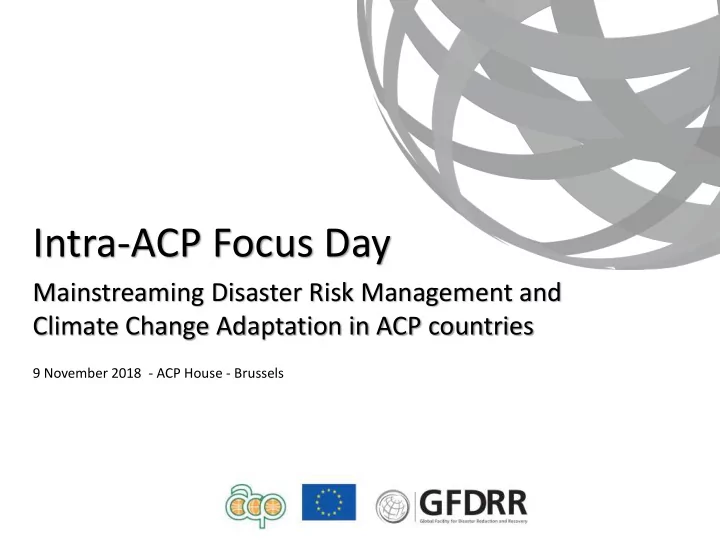

Intra-ACP Focus Day Mainstreaming Disaster Risk Management and Climate Change Adaptation in ACP countries 9 November 2018 - ACP House - Brussels
Intra-ACP Focus Day Mainstreaming Disaster Risk Management and Climate Change Adaptation in ACP countries Experience from Solomon Islands Community Resilience to Climate Change & Disaster Risk in Solomon Islands Project (CRISP) Judith Mary Alalo Ministry of Enviroment,Climate Change,Disaster Management and Meteorology 9 November 2018 - ACP House - Brussels
Solomon Islands spread over 1000km, 900 islands incl atoll island; population of 623,000
Solomon Islands – Highly Vulnerable country Geohazards: volcanic eruptions, earthquakes, tsunami Climate related: flash floods, coastal storm surges, tropical cyclones, land slides, sea level rise/saline water intrusion (low vulnerability to season drought)
Some Recent Disasters Earthquake – 2007 Cyclones 52 people killed; 304 communities Namu 1986 – 103 killed, 90,000 homeless, and 6,900 households affected about US$100 million in damage and loss 3251 houses destroyed; about 3,000 Nina 1993 – 5 killed, 30,000 people affected, houses damaged about US$20 million in economic damage & loss Fergus 1996 – 3 killed, 30,000 people affected, relief cost ~ US$1.9 million Zoe 2002/3 (cat 5) – 2,000 people affected, relief cost ~ US$1 million Flash and riverine flood – 2014 – Causes deaths
Institutional Set Up for DRM and Climate Resilience DRM Lead • Ministry of Environment Climate Change, Disaster Management and Meteorology (MECDM) agency • National Disaster Management Office - responsible for DRM during Preparedness, Response and Recovery through the disaster National Disaster Management (NDC) Act • . • Climate Change Division of the MECDM responsible for Climate Climate and Resilient Development resilience Arrangements for Disaster Management fall under the NDC Act. A new national Disaster Management Plan 2018,funded through CRISP, is being developed and supports improved arrangements and coherence
Work within existing country mechanisms so risk and DRM and resilience is embeded within each agency’s climate development planning, investments and practices of each sector Resilience accepted as CRISP is using the term ïnstreaming instead of mainstreaming , focusing on key specific targeted integral part activities within selected sectors (Health and Tourism as well as investments in remote communities – mostly for of water supply as it is being afected by many hazards development Instreaming across national, provincial government and community level. CRISP mainly at national level establishing institutional arrangements for intergration of CCA and DRR, supporting selected Provincial Governments
Challenges • Each sector struggles to understand and incorporate New Concept • Confusion in various terms and concepts and • Adds to agencies core businesses so often over Responsibilities looked • Limited or no budget allocation by sectors for risk Limited resilience but referenced in national development resources strategy • Remoteness and number of islands makes climate resilient development difficult to coordinate and Remoteness implement
Focus on the ACP-EU NDRR supported activities Improve early warning systems SI national data centre for geological risks. Improve relationships within 3 key SIG agencies Seismology, Meteorology, National Disaster & ICTSU SI National Observatory for Earthquakes & Volcanoes
ACP-EU NDRR Supported Activities Supporting Community Resilience through awareness of risk, resilience & resilient investments
Lessons learned Risk Resilience is everyone's business – reiterate it across all levels of government - national, provincial and community, but work within the local context Risk Resilience is very expensive - requires sufficient budgeting from design so vulnerable remote communities can be reached Remote communities should be treated as special cases i.e. special projects with more support (technical, procurement, logistics and financial)
Lessons Learned Budget Work within the local availability context for instreaming work Need to have a common language round climate and resilient development – What is it? Strong partnerships and coordination avoids duplication Treat sustainability as a key area
Recommend
More recommend